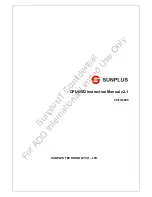
Crestron
C2N-DAP8
Digital Audio Processor
Operations Guide – DOC. 8186
Digital Audio Processor: C2N-DAP8
•
55
Surround Sound Decoder Digital Inputs and Outputs
SIGNAL TYPE
(I/O)
FUNCTION
Master_Mute
I
Mutes all surround sound audio for as long as the input is
high. When the input goes low, all eight channels un-mute.
Bypass
I
When high, this function bypasses the Global_Bass and
Global_Treble settings, as well as Graphic/Parametric EQ.
When in Bypass mode, the signal path is 24 bits rather
than 20 bits, resulting in slightly improved audio fidelity.
Alt_Mix I
Allows
alternate
downmix selection where speaker
presence alone is not sufficient to determine the desired
mix. In most applications, this signal can equal 0. Some
infrequently used downmixing modes can be selected by
setting this signal high. See the following:
Alt_Mix = 0
Alt_Mix=1
L/R
Lt/Rt
2/2
2/1
3/2
3/1
Note that the /1 in the 2/1 and 3/1 means that a single
surround signal is generated even though it is directed to
both the Ls and Rs speakers
Noise_Type
I
Selects between Standard Noise (if 0) and pink noise (if
1). Standard noise (Dolby Noise) is bandpass-filtered
noise centered at 750Hz with a 12dB/octave roll off. The
Subwoofer channel has its noise centered at 50Hz. Pink
noise rolls off at 3dB per octave starting at 23Hz.
Noise_L through
Noise_Sub
I
The noise generator is activated when a Noise_L through
Noise_Sub enable input is high.
To generate noise, the DSP stops decoding and enters
noise generation mode. This means that the previous
source needs to be manually re-selected after noise
generation is complete.
Mode_Trim
I
When high, this function stores the volume, volume trims,
and LFE trim values such that they are applied only to
whichever decoding mode is currently running. This allows
the volume and gain settings for a CD source, for
example, to differ from those for a Dolby Digital DVD.
If unused or set to zero, the trim values apply to all
decoding modes, and the feedback signals will report the
current settings.
If set to 1, the feedback signals will show the system trims
plus the mode-dependent trims for the current mode. The
factory default for all the mode-dependent trims is zero;
thus all modes default to the system trims. Adjusting the
trims with Mode_Trim =1 alters values stored in the mode-
dependent trims for the current mode.
Mute_L through
Mute_Sub
I
When high, cuts audio to indicated channel for as long as
input remains high. Audio un-mutes when input goes low.
Dyn_Range_MIN,
Dyn_Range_STD,
Dyn_Range_MAX
I
When high, will apply the indicated amount of
compression for Dolby Digital sources, as follows:
Dyn_Range_MIN provides highest compression ratio,
bringing dynamic range close to that of a TV broadcast.
Dyn_Range_STD provides dynamic range recommended
by sound engineers for general home viewing.
Dyn_Range_MAX provides full dynamic range of a
cinema.
The dynamic range digital inputs affect and will update the
High_Dyn_Range_fb and Low_Dyn_Range_fb signals
described later.
(continued on next page)














































